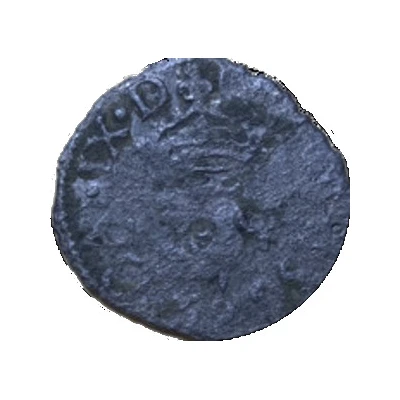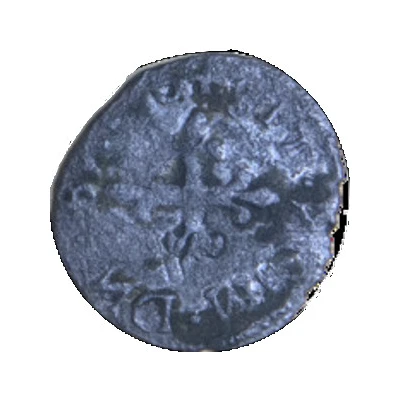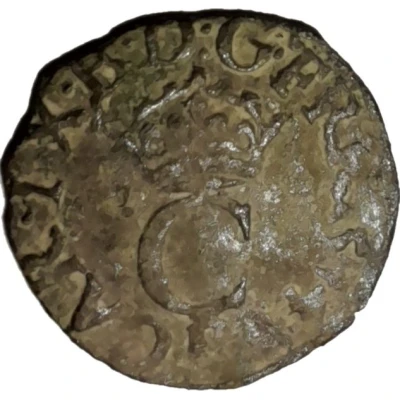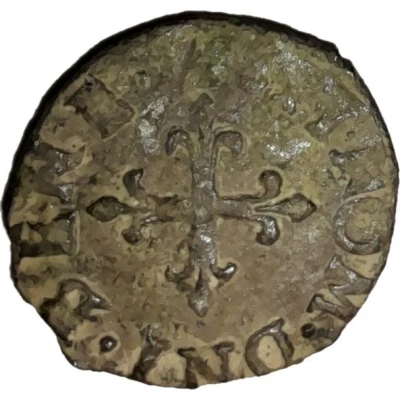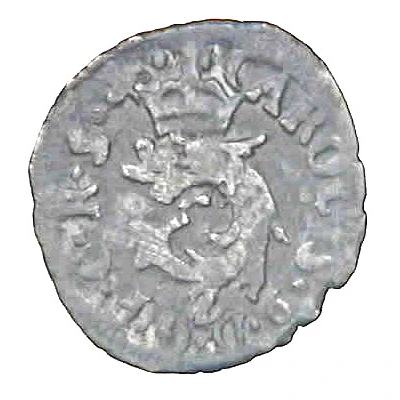


© CGB
Liard du Dauphiné - Charles IX - 2ème Émission
| Billon | 1 g | 17 mm |
| Issuer | France |
|---|---|
| King | Charles IX (1560-1574) |
| Type | Standard circulation coin |
| Years | 1573-1574 |
| Value | 1 Liard (1⁄80 LT) |
| Currency | Livre tournois (1204-1795) |
| Composition | Billon |
| Weight | 1 g |
| Diameter | 17 mm |
| Shape | Round (irregular) |
| Demonetized | Yes |
| Updated | 2024-10-04 |
| Numista | N#98255 |
|---|---|
| Rarity index | 90% |
Reverse
Cross fleurdelisée.
Script: Latin
Lettering: SIT. NO. D. BENE. D. T. 1573.
Comment
Born in Saint-Germain-en-Laye in 1550, son of Henri II and Catherine de Médicis, Charles IX succeeded his brother François II in 1560, at the age of ten. His mother was regent, and his cousin Antoine de Bourbon was lieutenant-general of the kingdom. His "reign" began with the Estates General held in Orléans in December 1560 - January 1561, and the Poissy colloquy (October 1561), at which Catholic and Protestant ideas came face to face. In January 1562, the Edict of Saint-Germain gave the Reformed virtual freedom to worship outside enclosed towns. The civil war between Protestants and Catholics began with the Wassy massacre (March 1562), when the Duc de Guise killed Reformed Protestants gathered in a barn. In response, the Prince de Condé took up arms and seized several towns. Forced to take sides, Catherine led the Catholics. Massacre followed massacre, and Protestants desecrated churches and tombs. The whole of France was soon ravaged by the troops of both sides. At the battle of Dreux (December 1562), Guise gave victory to the Catholic camp, but was assassinated a few months later, in February 1563. The Edict of Pacification of Amboise, in March 1563, was negotiated by Montmorency, for the Catholics, and Condé, for the Protestants. It granted freedom of worship to the nobles, in one town per bailiwick. Charles IX was proclaimed of age in 1563, and his mother set about re-establishing royal authority. The Ordinance of Moulins (1566) reduced the power of parliaments and governors. To restore harmony, the Queen Mother took her son on a long tour of France (1564) and led a glittering court life. Unhappy with the royal power's rapprochement with Spain, and dissatisfied with the application of the edicts, the Protestants planned to seize the king's person. The court fled to Meaux, then to Paris (September 1567). After a brief respite, disorder and massacres flared up again. The Protestants blockaded Paris and fought the indecisive battle of Saint-Denis (November 1567), where Montmorency was killed. Catherine's second son, Henri d'Anjou, took command of the royal armies. Peace was signed at Longjumeau in March 1568, reinstating the provisions of the Edict of Amboise. Against the backdrop of the Tridentine reaction, the Catholic party began to regain the upper hand. Mendicant orders and Jesuits were spreading the word. Armed brotherhoods were created. The Duc d'Anjou defeated and killed Condé at Jarnac (March 1569). Despite help from Protestants in Germany, the Protestants were defeated a second time at Moncontour (October 1569). A new edict of pacification, signed at Saint-Germain, intervened in August 1570: the Protestants were given four cities of safety: La Rochelle, Montauban, La Charité and Cognac. The Reformed lords returned to the Court, and Coligny became Charles IX's favorite. Jealous of this competition, Catherine resolved to lose the admiral. Thanks to the marriage of Henri de Navarre, nominal leader of the Protestant party, to Marguerite de Valois, the Catholic party took advantage of the gathering in Paris of numerous Reformed leaders: this led to the St. Bartholomew's Day massacre (August 24, 1572). The king and his mother had allowed themselves to be drawn into the affair, in which collective fury claimed most of the two thousand victims. The war resumed, inexpiable. The Midi had revolted, with the complicity of Montmorency-Damville, governor of Languedoc. The Edict of Boulogne (July 1573), which granted freedom of conscience and freedom of worship in La Rochelle and Montauban, could not put an end to the war. King of a kingdom torn asunder by events, Charles died without male issue on May 30, 1574, leaving the crown to his younger brother, Henri, King of Poland.Interesting fact
One interesting fact about the Liard du Dauphiné - Charles IX - 2ème Émission 1573-1574 coin is that it was minted during a time of great economic and political change in France. The coin was issued during the reign of Charles IX, who was known for his efforts to centralize power and stabilize the French economy. The coin's minting was likely a response to the need for a reliable and widely accepted form of currency, as the country was experiencing significant economic growth and trade at the time.
Price
| Date | Mintage | VG | F | VF | XF | AU | UNC |
|---|---|---|---|---|---|---|---|
| 1573 | 154080 | - | - | - | - | - | - |
Values in the table are based on evaluations by sales realized on Internet platforms. They serve as an indication only for Liard du Dauphiné - Charles IX - 2ème Émission 1573-1574 coin.
